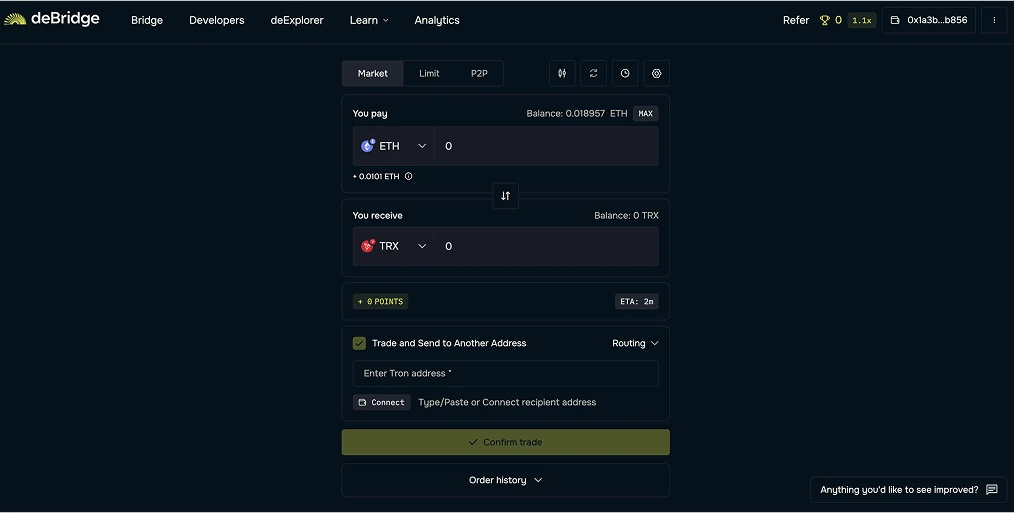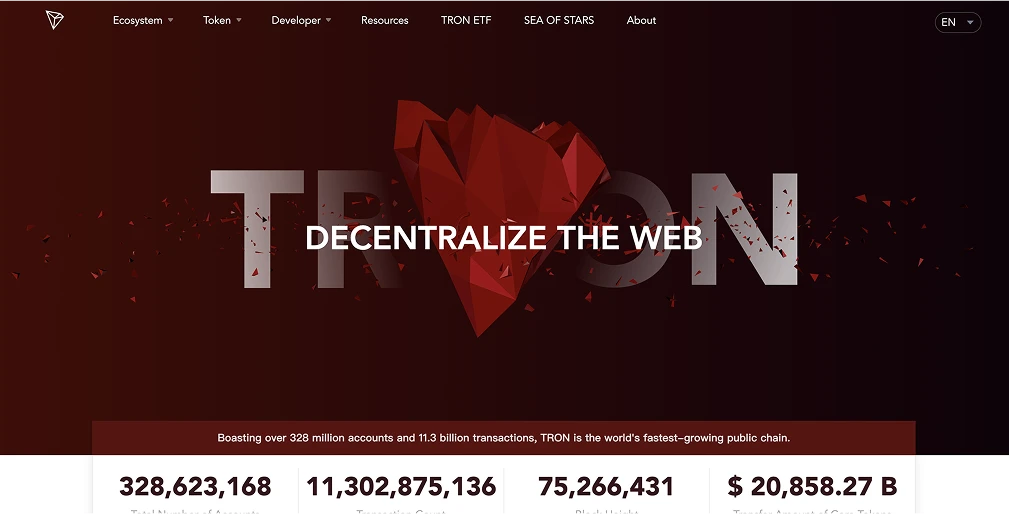How to Bridge to and From Tron (Any Chain)

Summary: deBridge provides the most reliable route for moving assets to Tron, combining near-instant settlement with a flat 4 TRX fee per transfer.
Simply link your wallet, set Tron as the destination, and transfer USDT for the most efficient execution. Once confirmed, your funds land on Tron within seconds, ready to use across its applications.
deBridge is the leading option to bridge to Tron, delivering ~2-second transfers, 100% uptime, a flat 4 TRX fee, and $12B+ settled without a single security breach.
Supported Networks
Tron, Ethereum, Solana & More
Available Assets
WETH, USDT, USDC & More
Verified Audits
Halborn, Zokyo and Immunefi
Can I Bridge to Tron?
Yes, you can bridge assets to the Tron blockchain using crypto bridges that support TRC-20 tokens. Commonly transferred assets include USDT, USDC,and ETH, which can be moved from networks like Ethereum, BNB Chain, or Polygon into Tron.
Once bridged, you’ll need a Tron-compatible wallet such as TronLink or Trust Wallet to manage your tokens. These wallets connect users with the Tron ecosystem, providing access to applications like JustLend (for lending and borrowing) or SunSwap (a leading Tron-based DEX).
How to Bridge to Tron (Any Chain)
The best way to bridge assets to Tron is with deBridge, a cross-chain protocol that supports over 25 networks. With more than $12 billion in transactions, zero downtime, and no security breaches, it’s proven to be one of the most reliable options available.
deBridge connects Tron with Ethereum, Solana, Base, Arbitrum, BNB Chain, Hyperliquid, and other major ecosystems, making it ideal for moving stablecoins and other widely used tokens.
Steps to Transfer with deBridge:
- Connect Wallet: Open the deBridge app and connect your source wallet (MetaMask, Phantom, or TronLink) along with your Tron-compatible destination wallet.
- Select Networks & Asset: Choose your source chain, set Tron as the destination, and pick a supported token such as USDC, USDT, or ETH. USDT is typically the most cost-effective and fastest option.
- Approve Transaction: Enter the amount, approve the token in your wallet, and confirm the bridge transaction on deBridge.
- Receive Funds: Complete the prompts to finalize. Your tokens will arrive on Tron within seconds, ready to use on dApps like SunSwap for trading or JustLend for lending.

Tron Bridging Fees
When bridging to Tron with deBridge, users face two costs:
- Bridge Fee: A fixed 4 TRX per transaction (roughly $1 at current prices), which goes toward validators and network upkeep.
- Network Gas Fees: Extra gas costs on the source chain. These vary depending on network activity, but Tron’s on-chain fees are extremely low, usually less than $0.01.
Altogether, bridging to Tron through deBridge typically costs around $1 per transfer, which is far cheaper than using Ethereum-based bridges where fees can run into several dollars or more.
Best Tron Bridges Compared
Users bridge to Tron for different reasons: cashing out USDT salaries, moving profits from Solana meme coins into yield farms, or just taking advantage of Tron’s low transfer fees. Each bridge has its strengths, whether it’s stablecoin support, speed, or broad token coverage.
Here’s a breakdown of the top Tron bridges and what they’re best for:
Tron Bridge Risks
Bridging to Tron with battle-tested protocols is generally safe, but it carries risks that investors should understand:
- Smart Contract Exploits: Bridges run on complex code that can be targeted by hackers. Past exploits on other networks have resulted in major losses. Using audited, widely adopted bridges reduces this risk.
- Phishing & Fake Sites: Scammers often create lookalike bridge websites. Always check the official URL and verify contract addresses before approving a transaction.
- Liquidity Shortages: Smaller or newer bridges may not have enough liquidity to process large transfers, which can lead to delays or failed transactions.
- Transaction Delays: Even reliable bridges can face slowdowns during network congestion or validator issues. Funds are rarely lost but may take longer to arrive.
- Custodial vs Non-Custodial Models: Some bridges temporarily hold funds in centralized wallets, which introduces counterparty risk. Non-custodial options that execute transfers directly on-chain are safer.
Tip: Start with a small test transfer before moving larger amounts, and always keep assets in a trusted Tron-compatible wallet.
What is Tron?
Tron is a blockchain designed for fast, low-cost transactions, using a Delegated Proof-of-Stake (DPoS) system where a set of Super Representatives validate blocks. This structure enables high throughput, low fees, and near-instant settlement, making Tron efficient for payments and stablecoin transfers at scale.
It is also the second-largest blockchain for stablecoins after Ethereum, hosting over $81 billion in USDT. Tron’s dominance in stablecoin settlement has made it the preferred network for remittances, OTC transfers, and cross-border payments, especially in regions where low-cost, fast transactions are essential.

Final Thoughts
Bridging to Tron is cost-effective, fast, and reliable when done with trusted protocols like deBridge. If you’re moving stablecoins or other tokens, always compare fees and supported networks before starting.
Using a Tron-compatible wallet ensures you can put your assets to work immediately on lending, trading, or payment applications, making the process both practical and rewarding.
Frequently asked questions
How can I track a Tron bridge transaction?
After submitting a transfer, you can monitor progress using the bridge’s built-in explorer or by pasting your wallet address into Tronscan. This shows whether the transaction is pending, confirmed, or completed on Tron.
What if my Tron bridge transaction is stuck?
If a Tron bridge transfer appears stuck, first check the transaction status on the source chain’s explorer and Tronscan. Most delays are due to network congestion or pending approvals. If the transaction is confirmed on-chain but funds haven’t arrived, contact the bridge’s support with your transaction hash for resolution.
Which wallets support Tron bridge transactions?
Popular options include TronLink, Trust Wallet, and MetaMask when connected through supported bridges. Always make sure your wallet is configured for TRC-20 tokens to avoid failed deposits.
What is the minimum transfer amount when bridging to Tron?
Most bridges set minimums between $10 and $50 to ensure fees are covered and transactions are economical. Limits vary by token and source chain, so confirm on the bridge interface before initiating a transfer.
%2520(1).webp)
Written by
Antony Bianco
Head of Research
Antony Bianco, co-founder of Datawallet, is a DeFi expert and active member of the Ethereum community who assist in zero-knowledge proof research for layer 2's. With a Master’s in Computer Science, he has made significant contributions to the crypto ecosystem, working with various DAOs on-chain.
.svg)
%20Philippines.webp)
%25201%2520(1).webp)
%20(1).webp)
%2520(1).webp)
.webp)




